Kingdoms of Amalur: Reckoning Gameplay Preview and Interview
by Adam
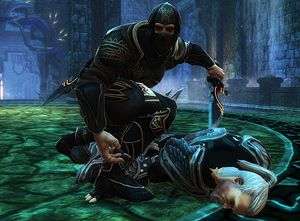 RPGs are enjoying a golden age. Naysayers will dismiss that opening statement by tossing the hats of games long gone into the ring for these fresh, upcoming fighters to do battle with for the crown. The genre itself has escaped its constraints of complicated mechanics, levelling systems that require star charts and maths degrees in order to navigate, and combat systems more akin to games of chess. Having caught the eye of our beneficent Editor in Chief at E3 this year, I was quick to respond to EA’s invitation to come and spend some time of my own with Kingdoms of Amalur: Reckoning, a game that is promising to deliver a killing blow to the old school RPG approach with its fast paced combat and classless approach to levelling.
RPGs are enjoying a golden age. Naysayers will dismiss that opening statement by tossing the hats of games long gone into the ring for these fresh, upcoming fighters to do battle with for the crown. The genre itself has escaped its constraints of complicated mechanics, levelling systems that require star charts and maths degrees in order to navigate, and combat systems more akin to games of chess. Having caught the eye of our beneficent Editor in Chief at E3 this year, I was quick to respond to EA’s invitation to come and spend some time of my own with Kingdoms of Amalur: Reckoning, a game that is promising to deliver a killing blow to the old school RPG approach with its fast paced combat and classless approach to levelling.
Sitting comfortably in a five star hotel suite, Ben Smith, a Producer with EA Partners who are working directly with Big Huge Games on Amalur, fired up a presentation video to talk me through the broader details of the game we covered in the aftermath of E3. Getting to see the game for myself confirmed every bit of praise Mark brought back from LA with him. The colour palette is truly superb, immediately bringing this fresh new world to life and, with everything that you seem to be able do when the pad is in your hands, appearing so responsive to the players desires, it’s hard to keep a grounded perspective.
The presentation began where all good RPGs do: character creation. A brief skim over the various customisation sliders and available races, and my mind was already racing to work out what kind of character I’d be creating when the game releases next year. Four races split across humans and elves, with both genders available for selection, and everything down from face shapes and hairstyles to tattoos and jewellery customisable for the player.
‘We want to give the player a ton of customisation options at their fingertips so that you can create a character you can fall in love with and would want to keep playing for thirty, forty or fifty hours’
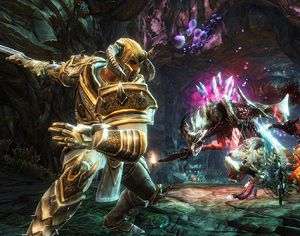 A quick tour over the five distinct locales in the game and Ben throws up some quick stats to support the boasted size of Amalur; over a hundred and twenty unique dungeons, four large cities, and dozens of towns that function as both quest and narrative hubs. Switching from the macro to the micro, the presentation shifted down to street level and the inner workings of Amalur’s society is put on show, with NPCs that each have their own daily schedule bustling their way through the city and presenting the less honourable of players, such as myself, with the temptation to do a little pick-pocketing. For the more creative and resourceful of players, the demonstration shifted to showing off a little of the games three crafting systems: Blacksmithing, Sagecrafting and Alchemy.
A quick tour over the five distinct locales in the game and Ben throws up some quick stats to support the boasted size of Amalur; over a hundred and twenty unique dungeons, four large cities, and dozens of towns that function as both quest and narrative hubs. Switching from the macro to the micro, the presentation shifted down to street level and the inner workings of Amalur’s society is put on show, with NPCs that each have their own daily schedule bustling their way through the city and presenting the less honourable of players, such as myself, with the temptation to do a little pick-pocketing. For the more creative and resourceful of players, the demonstration shifted to showing off a little of the games three crafting systems: Blacksmithing, Sagecrafting and Alchemy.
For Blacksmithing, nothing the player discovers in the world need go to waste with any weapon that isn’t usable, or below the player’s expectations, able to be broken down into its component parts, which are then available to be re-forged into better, more tailored armour and weapons. Sagecrafting focuses on the ability to buff your equipment by taking shards found in the world and turning them into gems, ready to slot into whatever equipment will accept the modifications and giving your favourite sword those all important flames of awesome. The alchemy side of crafting will reward the explorer, promising that the player can take the ingredients that they find out in the world and combine them into potions, either by adhering to a strict recipe or purely by experimentation.
What most impressed me when reading about the game prior to the presentation was this classless approach to the RPG that Big Huge Games and 38 Studios were taking with Amalur however, Ben acknowledged that in saying that Reckoning doesn’t have a class system, it probably sounds like a class system itself. The Destiny system won’t force the player into making such a great commitment so early in the game, or indeed throughout the game, it will instead watch the player, track what skills and abilities the player is using and then issue them with a Destiny card, applicable at any stage in the game, that will help channel those predominant skills the player is shown to be relying on and buff them up so that the player can better define themselves and identify with the role that they want to play.
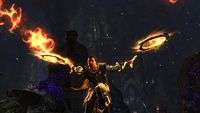 |
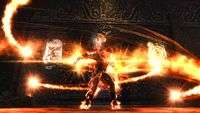 |
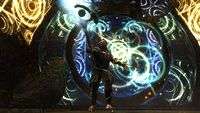 |
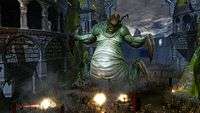 |
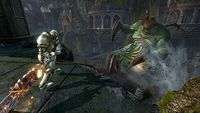 |
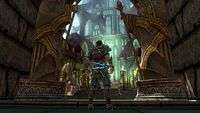 |
Having covered the basics, the presentation then switched to a demonstration of live, pre-alpha code so that I could see for myself how the game is shaping up and if it’s able to deliver on all of these very ambitious promises. I was really taken aback as I watched the onscreen avatar stroll through the cave where the demo was set, as the world really was reacting to the players presence, with the fauna on the cave walls blossoming with Arcana as the player passed by, making you feel that little bit more special, more powerful, and more responsible for the fate of Amalur.
Hurrying on through the caverns, we eventually encountered a group of bandits, and my first demonstration of live combat was upon me. I had my pen poised to hurriedly scribble down some of the facts and thoughts Ben was constantly relaying to me but Ben wanted me to enjoy this and even if he was talking, I don’t think I’d have heard him. Throughout the presentation, I’d caught glimpses of the three-tree, multi-tier levelling system and struggled to keep myself objective, to remain grounded, and not get sucked into the marketing blurb that combat was going to revolutionise the RPG with Amalur, but once that first sword was swung, any cynicism I had was instantly lifted.
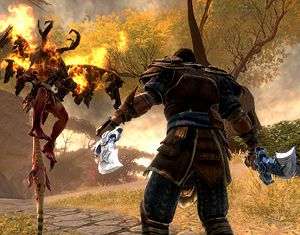 The character on screen was dancing from enemy to enemy, trails of fire and ice streaking across the screen, as Ben actively switched from the sword on his back to the pair of daggers at his side before launching up into the air and then slamming down for one final, devastating earth attack. It was all so seamless and fluid, with no visible degradation to performance, and at such an early stage in development, it was hard not to be stunned by what I’d seen. Once the dust had settled, Ben explained that quick taps of the d-pad were allowing him to switch between both of his equipped weapon sets whilst button presses on the other side of the pad were creating expressive combo attacks that were tying the game’s magical abilities straight in to the combo as though they were standard ‘A,A,A,A’ attack patterns.
The character on screen was dancing from enemy to enemy, trails of fire and ice streaking across the screen, as Ben actively switched from the sword on his back to the pair of daggers at his side before launching up into the air and then slamming down for one final, devastating earth attack. It was all so seamless and fluid, with no visible degradation to performance, and at such an early stage in development, it was hard not to be stunned by what I’d seen. Once the dust had settled, Ben explained that quick taps of the d-pad were allowing him to switch between both of his equipped weapon sets whilst button presses on the other side of the pad were creating expressive combo attacks that were tying the game’s magical abilities straight in to the combo as though they were standard ‘A,A,A,A’ attack patterns.
‘What we think makes combat even more special is the way the RPG system is underneath to support it and make it better if you’re doing both well. So for example, it’s about applying your ability tree skill points to the right weapon, the right armour and the right abilities to supplement the way you’re going to play the game. So as a Warrior it’s about being able to do damage and take damage, as a Mage it’s about choosing weapons and abilities that get you out of harm’s way so you can throw off spells but then wade back in because our melee combat really is, whatever your class is about, getting in close and doing a certain amount of damage that way.’
Switching then to stealth mode, the next portion of the demo showed off some vicious, quick and silent kills (aptly named ‘The Stabby Stabby Move’ by Ben) as well as demonstrating some of the other non-combat features of the game, such as the disarming of traps and chests. Not content with having already sold me on the combat, the final sequence of the live play demo introduced me to the titular combat feature: Reckoning mode.
‘You may have seen during the combat stuff we’ve been doing, like when a I finished a combo move and when we had that last stealth kill, these blue threads of energy come out of the enemies and went into the player and that is a visual representation of that ‘fateless’ quality of our main character and what makes him special in the world. Everybody in the world of Amalur at this time of their history has a fate. If you go to a Fate Weaver, they can tell you,’ yeah dude I’m sorry but you’re going to die by falling down a hill and breaking your neck and you are going to die that way no matter what you do!’ The player doesn’t have a fate. Each time he kills somebody he’s severing their fate differently from where it should be so that’s what that blue energy represents, it’s you sundering fate and gaining power from it.
Mechanically speaking, what that means is that we’re filling the meter up at the top left hand corner. When it’s full, it gives you access to what we call Reckoning mode, and Reckoning mode is what we call the final expression of our combat loop. It’s got an interesting graphical effect – time slows down, enemies slow down, you get more powerful and you go faster. So what it’s meant to be is if you see a tough encounter and you’re not sure that you can get through, you apply Reckoning mode, you get through it or if you want to get more XP and Fate out of a group of enemies, then you might apply it then if you don’t think you have other plans for it just now.’
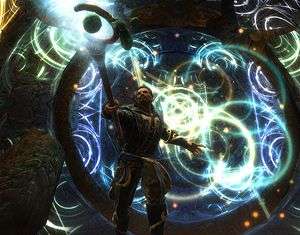 Sure enough, just waiting for us around the next corner was that monster that you knew would be an absolute demon to take down. Ben deliberately refrained from entering Reckoning mode as soon as combat began, just to highlight the difference it would make once it was active. With a subtle nod and a spark in his eye that was just as desperate to watch me enjoying the on screen action as much as it was keen to focus on showing off the best the game has to offer, Ben fired it up and completely turned the fight on its head. The background greyed, the colour of the attacks became so much more vibrant and employing the Fateshift Kill as the finishing attack, the Niskaru demon was torn asunder, launching its blue ribbon of fate up into the air before streaming down into the player.
Sure enough, just waiting for us around the next corner was that monster that you knew would be an absolute demon to take down. Ben deliberately refrained from entering Reckoning mode as soon as combat began, just to highlight the difference it would make once it was active. With a subtle nod and a spark in his eye that was just as desperate to watch me enjoying the on screen action as much as it was keen to focus on showing off the best the game has to offer, Ben fired it up and completely turned the fight on its head. The background greyed, the colour of the attacks became so much more vibrant and employing the Fateshift Kill as the finishing attack, the Niskaru demon was torn asunder, launching its blue ribbon of fate up into the air before streaming down into the player.
With this final act ending the demonstration, another short sampling of where that particular quest continues on to was ran in real time and my hunger for the game was now growing to an uncomfortable level. Much like the Helm’s Deep sequence of The Two Towers, a besieged Keep at Mel Senshir was previewed where a disheartened army of Soldiers were shown to be struggling to fend off the Niskaru, with flaming arrows raining through the sky and stone walls exploding like barrels of water, causing untold damage to the environments and sounding a call to arms to the gamer within me to get involved and do something about it. Knowing that Ben had recruited one more follower to this brand new IP, he smiled as he laid the pad down to rest and offered to answer any questions I may have for him.
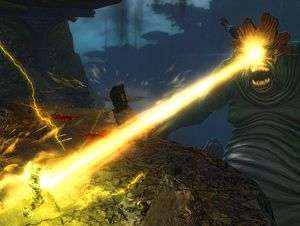 So a twice awarded Sports Illustrated Sportsman of the Year (Curt Schilling –Chairman of 38 Studios), A world renowned Comic Book creator (Todd McFarlane –Creator of Spawn) and a novelist (R.A Salvatore) who, as you said earlier, 22 times at the top of the New York Times Bestsellers list…
So a twice awarded Sports Illustrated Sportsman of the Year (Curt Schilling –Chairman of 38 Studios), A world renowned Comic Book creator (Todd McFarlane –Creator of Spawn) and a novelist (R.A Salvatore) who, as you said earlier, 22 times at the top of the New York Times Bestsellers list…
…and Ken Rolston (Lead Visionary Director –Big Huge Games), don’t forget Ken…
…all walk into a bar…
[Laughing]
It seems like such a bizarre A-List; what can you tell me about 38 Studios and how they’re approaching the video game industry?
Well I can tell you that Curt is a super passionate gamer. He was an MMO gamer while he was a Baseball player; I don’t know if you guys have heard the story, but he likes to talk about how as a Pitcher, he would only play once every five days so he’d spend the other four days playing EverQuest and he’d be playing it with his kids so he could keep in touch with them. He didn’t go out carousing like some Baseball players or Premier League players do, he was playing EverQuest. Turns out Bob (R.A Salvatore) also played EverQuest and so those two had a natural connection for gaming and they were sort of like a mutual appreciation society. Bob loves sports, Bob loves baseball, Curt Schilling won a world series for his team so of course he wanted to meet Curt. Curt loves fantasy novels – I had the most interesting conversation with Curt about Game of Thrones that I’ve ever had in my life about the books, not the TV show, with Curt Schilling. So they just wanted to meet, and Curt always wanted to run a game company, so he just made one.
So that’s kind of 38 Studios and how he met Bob. Todd was a Minor League Baseball player, he has gone out and bought baseballs like Mark McGuire’s whatever number home run it was, 62 that year? Todd doesn’t play games but he does live in that space like those guys do and so I think that Bob might have known Todd first, I’m not sure but those guys came together because Curt was looking for somebody who could help him form the visuals of the whole IP. Ken worked for Big Huge Games already when 38 acquired them, so Ken came into it more naturally than the other guys did as a game developer.
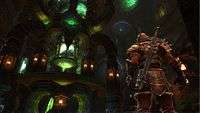 |
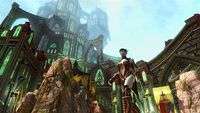 |
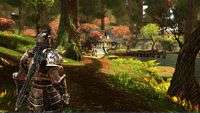 |
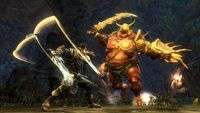 |
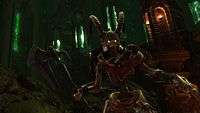 |
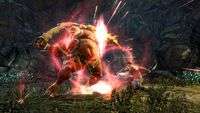 |
What can you tell me about the relationship between 38 Studios and Big Huge Games?
So Big Huge Games are primarily the guys that are building this game; 38 owns the overall IP and so it’s kind of crucial for the Big Huge guys to know if what they’re building is fitting into their IP and that’s kind of the feedback loop. It’s like, do these things make sense? Yes absolutely, great -they go build it and that stuff. The interaction mostly at this point, because we’re so far along in development, is probably not as much as it was back then at the concept art stage for a lot of this stuff. 38 are mostly doing their own thing on its products, mostly building the Kingdom of Amalur MMO.
Big Huge Games obviously have this massive pedigree with RTS games, that’s how they first broke on to the scene with things like Rise of Nations as well as their work on Age of Empires III, what prompted the move for them to switch over to RPG’s?
We started this relationship three years into BHG building an RPG…
…Isn’t it that they were actually working on it back when they were still under THQ?
I was actually part of the EAP Team that they pitched the RPG to before they signed with THQ, so I met Ken and Tim Train who ran the company back then and then years later we actually came back and went forward with them. They saw an opportunity when Ken left Bethesda, to bring him on board and do something different, I think they…I actually can’t speak for them except on things they’ve told me but they supposedly looked to the PC RTS future and were like….Oh My….what do we do? What do we want to do? And the team kind of unanimously decided well, we all love RPGs, we’d love to build RPGs, let’s build an RPG! I think Ken came aboard and then they hired a few other folks from Bethesda over time and folks from other RPG developers. They’ve got a couple of staff on from Iron Lore, which is now defunct, who made Titan Quest which is a pretty good RPG with a Diablo loot system and they’re just a really talented bunch of guys – very multi-talented bunch of guys and women. So, it’s taken a long time for them to get here but what you see is pretty amazing for guys who started building RTS’.
Obviously, Big Huge are no strangers to creating an entirely new IP, with Rise of Nations being that amazing stand out title back then and it seems that, now more than ever, the games we see coming out are sequels and Amalur is an entirely fresh and new IP. How important do you think it is to have a studio of their calibre working on a new IP that has the audacity, so to speak, and go against the current flow of the market?
I think having a really talented group of guys who have shipped really cool quality titles in the past is critical to any game you make, let alone any new IP. There are a lot of challenges that come with a new IP game which, as you know, is part of the reason why we’re out here showing it off to you guys, is that we want people to fall in love it like the way we have and talk about it the way you do, as you guys are more credible than we are when we do. I think it is super important, but it’s also super important to have a high quality team doing anything really.
Moving on to Kingdoms of Amalur, it seems to be that RPGs are the games these days that are taking all the headlines as far as the gaming press goes. What do you think it is that has allowed the RPG genre to move to that main stage?
My personal theory is that the great thing about an open world RPG, is that there’s something for everyone. No matter how you like playing an RPG, and even if you don’t necessarily like RPGs but you like a certain component of it, you can go into an open world RPG and probably satisfy that itch and just have fun. It’s not just one style of player that likes or wants to play the game, it’s about 14 different styles of player that would be perfectly happy to go in and fish (not in our RPG!) but just happy to craft, explore and kill things. I’m an OCD gamer, I go into a town and just take every quest and then I will do those and then I come back and then I move on to the next town. So I think the advantage we have in doing a game of this genre is that it appeals to a lot more people in different ways.
With there being a lot more RPGs around these days, what is the absolute key, standout, shining trophy for Kingdoms of Amalur that’s going to be attracting people?
I think we hope that it’s a package deal but I think the combat is what stands out the most. With a really good RPG, the way something really stands out is if all the little things work together to be an awesome package. So we locate four things we see working together really well that can make a game like Kingdoms of Amalur special. The big open world and RPG systems being one layer, the combat on top of it that nobody else has done but is moment to moment fun and is informed by the RPG systems working underneath it, and then our unique Destiny systems, supporting you not having to make decisions before you understand what you’re doing and then feeding that back into the decisions you’ve already made to make you feel more powerful and then wrapping all of that into a kind of world lore player story thing that the main quest is -this big world at war, a player whose come back to life and doesn’t know [who he is]. It’s kind of a trope but, it’s a trope for a reason. It works. You don’t know who killed you, you want to go and find that out and hey, that happens to interweave with the world story and off you go.
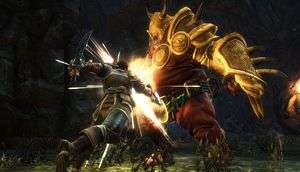 Games follow some fairly odd trends, you can always look at a particular era of gaming and see something that seems to be quite common to a lot of games. I have some quick fire questions here and these are Yes/No so feel free to just fire them off as they come, and bear in mind that these answers might help to sell you an extra ten or twenty thousand copies. So, is Kingdoms of Amalur going to feature… Zombies?
Games follow some fairly odd trends, you can always look at a particular era of gaming and see something that seems to be quite common to a lot of games. I have some quick fire questions here and these are Yes/No so feel free to just fire them off as they come, and bear in mind that these answers might help to sell you an extra ten or twenty thousand copies. So, is Kingdoms of Amalur going to feature… Zombies?
Not technically Zombies…There’s some undead though!
Hats?
Hats?! Helmets! [Laughing] They’re like hats except they protect you!
Cake?
There probably are cakes somewhere in the game. Someone who works on the game is nicknamed Cake, does that count?
I’ll give it that.
[Laughing]
Dragons?
What’s a Dragon?
[Laughing] Ok so I’ll save asking you about Zombie Dragons that wear hats and eat cakes. And that’s Trademarked!
[Laughing] So no Zombie Dragons?!!
So who are the Big Bad of Amalur?
The Big Bad? We will reveal him later.
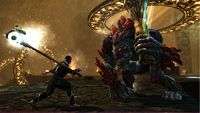 |
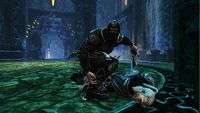 |
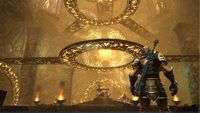 |
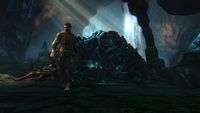 |
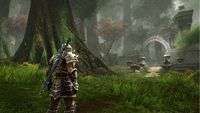 |
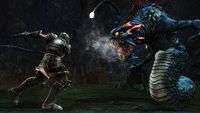 |
The game obviously has this superb kind of art style, instantly very attractive and doesn’t seem to go along the same lines of what a lot of Western RPGs are going for. They seem to be going for the more dull, basic colour palettes whereas Amalur seems to be going with a much more vibrant appeal. What do you think has prompted this return to the JPRG approach to presentation?
I would say that only part of the world that fits that description is the starting area and we intentionally made that part of the world for the player because we want them to feel comfortable and safe in a particular location before we thrust them into the crazy goings on in the world. Something that our creative director talked about, and it’s something Bob says, is that the player has to fall in love with the world and you don’t make a player fall in love with the world if it’s this blasted wasteland and this nasty mess of Zombie Dragons shambling everywhere. So I would say that it was partly that we wanted to have an appealing starting environment and the progression of the game will take you into areas which are less like what we’ve been showing today; we just haven’t shown a lot of the other environments yet.
Obviously R.A Salvatore is onboard; he pretty much wrote the book on Faerun, the predominant setting for the D&D World. With Kingdoms of Amalur, he’s said to have created a 10,000 year history for the entire world, how much is that helping to shape the entire story for the game?
Tons! The idea of Fate comes from that, the idea of the Well of Souls is integral to the entire IP, some of the iconic characters that run through this game will have off shoots in other parts of the IP as well, so it gives a foundation for the game designers and narrative designers at Big Huge to play with. This character seems really friggin’ cool; I want to use it and they get to go use it. There’s a lot of back-story you don’t have to worry about, thanks to Bob who has created this 10,000 year bible to drop on your table. Constraints are good in different ways, there are some things that enables and some things that disables like, no Zombie Dragons because Bob says so…
Todd MacFarlane’s on board too, and such a major talent from the Comic industry. How hands on is he in working with the art team?
He’s fairly hands on in terms of giving feedback. They have weekly, I think it may still be weekly, reviews with the entire art team on animations, on the Fateshift kills you saw, on environments and all that stuff. He gives a lot of feedback and it’s all really good feedback.
More technically then, Ken Rolston, who always seems so mad with passion whenever you watch an interview with him, he’s such a brilliant guy to listen to. He’s obviously worked on some of the biggest RPGs in recent game history, if there’s one name you can put next to the title ‘Lead Creative Visionary’ it’s his. Just what kind of impact is he having and how fantastic is it for the team to work with someone of his amazing experience?
Besides the fact he actually works for Big Huge, it’s sort of similar to the asset that R.A is. Someone who’s done it and knows what works and what doesn’t and knows all of the things he wants to try and make work and [to then] provide that to the team is super invaluable. In several ways, [he’s] a voice of reason and of madness depending on the day. He doesn’t do any hands on development himself but he does writing, he reads narrative stuff and provides feedback which is all really awesome too. Mostly as a guiding hand both for, ‘Yeah! You should do that’, and, ‘Nonononononononono! You should not do that!’
Sadly, my time with Kingdoms of Amalur was brought to an end here. With a handshake and a grateful ‘Thank You’ to Ben, I packed up and moved on. I thank Ben once more for his time and his passionate answers. When you can see just how in love a Producer is with their title like Ben was with Amalur, you know that this isn’t just another game.
Kingdoms of Amalur: Reckoning is set for release in 2012 and I promise you, this is not the last you’ve heard from us on this.
Last five articles by Adam
- Party Pooper
- Battlefield 3 - Review
- Red Orchestra 2: Heroes of Stalingrad - Review
- Burnout CRASH! - Review
- Dead Island - Review















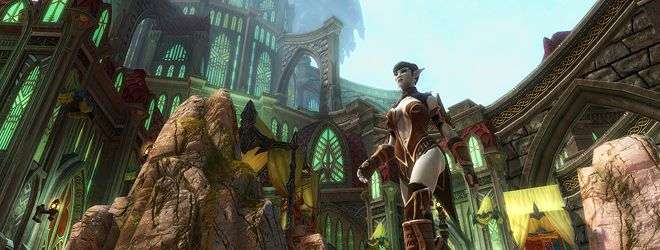
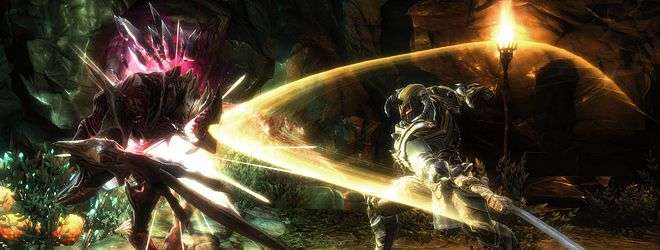
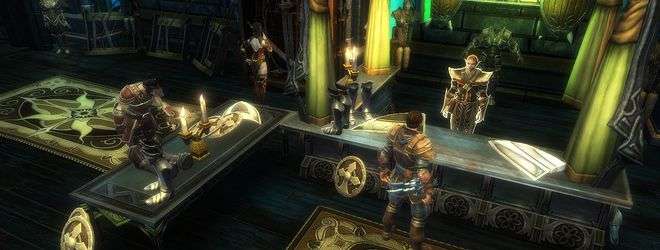








I like the odd RPG, but the ones that are more easily accessible and more importantly the ones that have a story that grab me, I just don’t get on with stat trees etc.
This looked amazing, I like the idea of the story and the fact it has a 10,000 year history already attached to it, which will hopefully give the story more direction and it can pull into things from this history making you believe it is a living breathing world.
The combat reminded me a little of God of War, fast paced and varied depending on the weapons you changed to during the battles.
This is on my radar, big time.
Amalur sounds like Sylvester Stallone in the Judge Dredd movie.
Still, colour me ‘tentatively interested’ about this one.
After the recent disappointments in terms of RPGs (I’m looking at you Dragon Age 2) this seems to be on the right track.
Hopefully the experience you saw Ben play through will be continued throughout the entire game and I have high hopes considering how passionate he seems to be about it. This is definitely on the watch list and I hope it reaches the potential that it should.
I seriously expect that this will be the game everyone leaves GamesCom next month talking about. It’s got such a fantastic tempo to it in the combat and is plenty busy outside of it that a lot of people from all corners of RPG are going to want to really sink their teeth into it.
Adam, this interview is nothing short of fantastic. Incredibly informative, and bloody hilarious to boot!
I’m starting to look forward to this game a lot more, and it’s looking darn interesting too.
Great job!